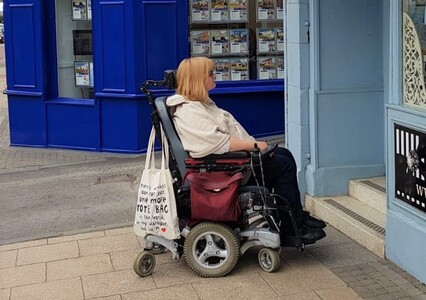To: Mark Harper and Shirley Ann Somerville
Let Us In

Make changes so that wheelchair users can be part of society.
Why is this important?
Wheelchair users are being discriminated against every day, in all walks of life - education, work, homebuilding and social life. They are being denied access to buildings, venues and premises that other people in our society enjoy.
Non-wheelchair users are often unaware of the obstacles wheelchair users face. Wheelchair users may want to join in with things but are being denied the opportunity to. The world puts up so many barriers .
For instance, going to the theatre is an experience enjoyed and cherished by many families, especially during the festive season. However, like many other activities, theatres and shows often fail to be wheelchair accessible.
Although the accessibility of venues has improved, wheelchair access is often forgotten, or indeed never thought about.
I acquired my disability in 2010, and was plunged into a World that I didn’t know existed. I found that I couldn’t go here, couldn’t go there, couldn’t do this, couldn’t do that. It’s torture.
The Equality Act describes disability as a ‘protected characteristic’. However, the Act is neither monitored nor enforced. If I think someone is in breach of the Act, it is up to me personally to raise a court action. As the majority of wheelchair users will be surviving on DLA/PIP, this means that this is outwith the realms of affordability for most of us. Is it deliberately cost prohibitive? This Act is nothing more than lip service – a façade to wrongly give the impression that the Government gives a damn.
I was concerned about the number of premises which appeared to be inaccessible in the City Centre of my home town of Edinburgh, so I undertook my own accessibility survey. The results revealed some gobsmacking figures. I surveyed 130 properties on Lothian Road/Bread Street/Grassmarket on the West side of the City Centre. A massive 95 (73%) are NOT wheelchair accessible. This is Edinburgh, home of the Edinburgh International Festival and World famous Hogmanay celebrations and Scotland’s capital city, in the 21st Century. It’s appalling. This means that I would have to raise 95 court actions! Everyone who asked what I was doing during the survey made the same comment – “I thought everywhere was/had to be accessible now/these days”.
I am not niaive to believe that this situation is confined to one City. The issue exists in every village, town and City, UK-wide.
Wheelchair access needs to be a pre-requisite of planning permission for old AND new buildings. Inaccessible premises change ownership, undergo extensive refurbishment and re-open as ‘newly opened’ businesses, and are still inaccessible! How is this being allowed to happen?
Non-wheelchair users are often unaware of the obstacles wheelchair users face. Wheelchair users may want to join in with things but are being denied the opportunity to. The world puts up so many barriers .
For instance, going to the theatre is an experience enjoyed and cherished by many families, especially during the festive season. However, like many other activities, theatres and shows often fail to be wheelchair accessible.
Although the accessibility of venues has improved, wheelchair access is often forgotten, or indeed never thought about.
I acquired my disability in 2010, and was plunged into a World that I didn’t know existed. I found that I couldn’t go here, couldn’t go there, couldn’t do this, couldn’t do that. It’s torture.
The Equality Act describes disability as a ‘protected characteristic’. However, the Act is neither monitored nor enforced. If I think someone is in breach of the Act, it is up to me personally to raise a court action. As the majority of wheelchair users will be surviving on DLA/PIP, this means that this is outwith the realms of affordability for most of us. Is it deliberately cost prohibitive? This Act is nothing more than lip service – a façade to wrongly give the impression that the Government gives a damn.
I was concerned about the number of premises which appeared to be inaccessible in the City Centre of my home town of Edinburgh, so I undertook my own accessibility survey. The results revealed some gobsmacking figures. I surveyed 130 properties on Lothian Road/Bread Street/Grassmarket on the West side of the City Centre. A massive 95 (73%) are NOT wheelchair accessible. This is Edinburgh, home of the Edinburgh International Festival and World famous Hogmanay celebrations and Scotland’s capital city, in the 21st Century. It’s appalling. This means that I would have to raise 95 court actions! Everyone who asked what I was doing during the survey made the same comment – “I thought everywhere was/had to be accessible now/these days”.
I am not niaive to believe that this situation is confined to one City. The issue exists in every village, town and City, UK-wide.
Wheelchair access needs to be a pre-requisite of planning permission for old AND new buildings. Inaccessible premises change ownership, undergo extensive refurbishment and re-open as ‘newly opened’ businesses, and are still inaccessible! How is this being allowed to happen?
